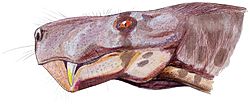Gorgonopsid facts for kids
Quick facts for kids GorgonopsiaTemporal range: Middle to Late Permian
|
|
|---|---|
 |
|
| Gorgonops | |
| Scientific classification | |
| Kingdom: | |
| Phylum: | |
| Class: | |
| Order: | |
| Suborder: |
†Gorgonopsia
Seeley, 1895
|
| Family: |
†Gorgonopsidae
Lydekker, 1890
|
| Subfamilies | |
|
Gorgonopsinae |
|
The Gorgonopsids were a fascinating group of ancient animals. They belonged to a larger group called Therapsids. These Therapsids were special because they eventually evolved into mammals, including us!
Gorgonopsids were very successful creatures. They lived during a time called the Permian period, about 260 million years ago. Sadly, they all died out during a huge event called the Permian–Triassic extinction event. This was one of the biggest extinctions in Earth's history.
Contents
Meet the Gorgonopsids: Ancient Predators
Gorgonopsids were the top predators of their time. Imagine a fierce hunter with a powerful, square-shaped jaw! They had huge, sharp, sabre-like teeth, perfect for catching prey. Many fossils of these amazing animals have been found in South Africa.
The Giant Inostrancevia
The biggest known Gorgonopsid was called Inostrancevia. It was as large as a big bear! Its skull alone was about 45 centimeters (18 inches) long. And its sabre-like teeth could be up to 12 centimeters (almost 5 inches) long. That's longer than your finger!
Gorgonopsid Families
The Gorgonopsidae family is divided into three main groups, or sub-families:
- Rubidginae: These Gorgonopsids had large, wide skulls.
- Gorgonopsinae: This group included most of the different types of Gorgonopsids.
- Inostranceviinae: This group included the largest Gorgonopsids, like Inostrancevia.
Images for kids
-
Reconstruction of Gorgonops
-
Reconstruction of the head of Eriphostoma microdon, one of the most basal gorgonopsians known from South Africa.
-
Reconstruction of the head of Arctognathus curvimola, a gorgonopsid know from South Africa.
-
Artist's impression of the head of Dinogorgon rubidgei, a rubidgeine known from fossils from South Africa and Tanzania.
-
Tetrapod distribution and temperature belts through the Upper Permian and Early Triassic
See also
 In Spanish: Gorgonopsia para niños
In Spanish: Gorgonopsia para niños
















